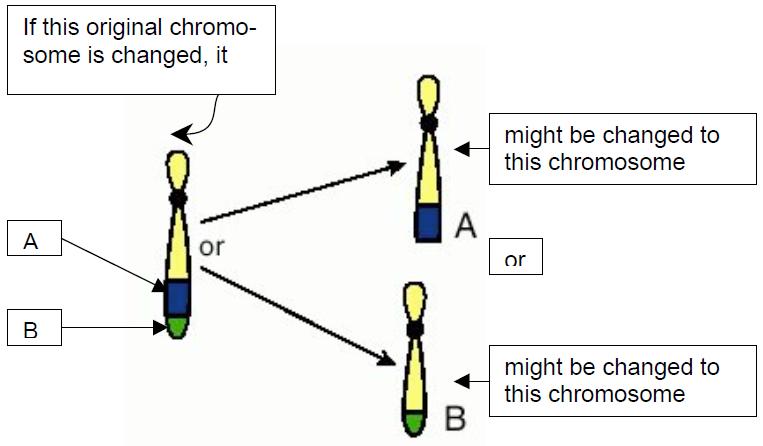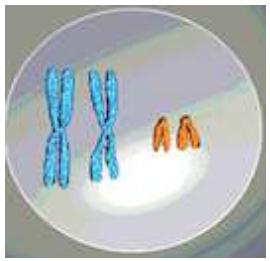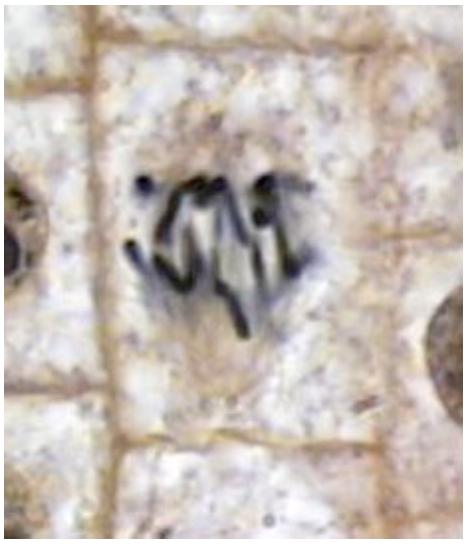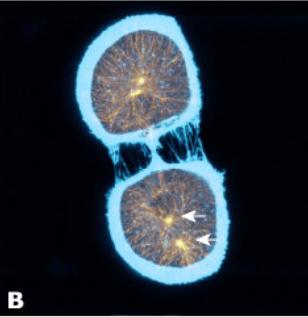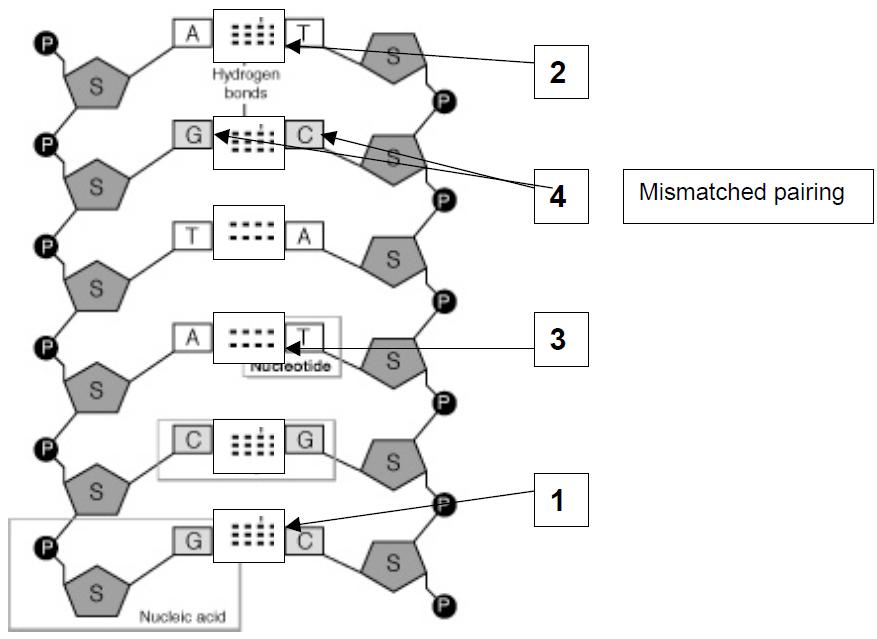Human Biology Exam Quiz!

.
- 1.
In a cell undergoing cellular reproduction which of the following stages have no chromatids?
- A.
Prophase
- B.
Anaphase
- C.
Metaphase
- D.
Telophase
Correct Answer
B. AnaphaseExplanation
During anaphase, the sister chromatids separate and move towards opposite ends of the cell. At this stage, each chromatid is considered as an individual chromosome. Therefore, there are no chromatids in anaphase.Rate this question:
-
- 2.
Which portion of the meiotic cell division directly follows telophase and cytokinesis of the first cell division?
- A.
Replication of DNA
- B.
G2
- C.
S Phase
- D.
Prophase of the next division
Correct Answer
D. Prophase of the next divisionExplanation
After telophase and cytokinesis of the first cell division in meiosis, the next phase that directly follows is the prophase of the next division. In this phase, the chromosomes condense again, the nuclear envelope breaks down, and the spindle fibers start to form. This prepares the cell for the next round of cell division.Rate this question:
-
- 3.
If a cell is to undergo mitosis which of the following is not true?
- A.
Both members of a chromosome pair will be replicated.
- B.
Both members of a chromosome pair will attach to the spindle.
- C.
The mother cell will end up with four times the amount of DNA after Interphase has occurred.
- D.
There is only one Interphase in each cell reproductive cycle.
Correct Answer
C. The mother cell will end up with four times the amount of DNA after Interphase has occurred.Explanation
During interphase, the DNA in the mother cell is replicated, resulting in two identical copies of each chromosome. Therefore, the mother cell will have twice the amount of DNA after interphase, not four times.Rate this question:
-
- 4.
In cellular reproduction, if one sees the chromosomes of a cell aligned at the center of the cell in a straight line, this cell may:
- A.
Be considered a diploid cell.
- B.
Be in the G1 phase of cellular reproduction.
- C.
Be in either the G1 and G2 phases of cellular reproduction.
- D.
Have moved directly into anaphase from prophase.
Correct Answer
A. Be considered a diploid cell.Explanation
If one sees the chromosomes of a cell aligned at the center of the cell in a straight line, this indicates that the cell is in metaphase of cellular reproduction. During metaphase, the chromosomes align at the center of the cell before they are separated and pulled to opposite ends during anaphase. Since the question does not mention any other characteristics or stages of cellular reproduction, it is not possible to determine if the cell is in the G1 or G2 phase. However, the fact that the chromosomes are aligned in a straight line suggests that the cell has a complete set of chromosomes, which is characteristic of a diploid cell. Therefore, the correct answer is that the cell may be considered a diploid cell.Rate this question:
-
- 5.
The purpose of anaphase is to:
- A.
Eliminate one chromosome of each pair.
- B.
Cause the cell to grow before cytokinesis.
- C.
Allow separation of the chromatids of each chromosomes.
- D.
Make more DNA before telophase.
Correct Answer
C. Allow separation of the chromatids of each chromosomes.Explanation
Anaphase is a stage in cell division where the chromatids of each chromosome separate and move towards opposite ends of the cell. This process ensures that each daughter cell receives a complete set of chromosomes. Therefore, the purpose of anaphase is to allow the separation of the chromatids of each chromosome.Rate this question:
-
- 6.
If one has the following sequence of bases, what will be the nucleotide base which one would predict to correctly replace the X? A A A G G G G C C C C T T T AT T T C C C C G G G G A A A X
- A.
C, because there cannot be four A's in a row.
- B.
It is not possible to predict what will occur at X.
- C.
U, because RNA is being produced.
- D.
T, because this is DNA.
Correct Answer
D. T, because this is DNA.Explanation
The given sequence of bases indicates that the X position is a nucleotide base. The sequence contains A, G, C, and T bases which are the building blocks of DNA. Since the question asks for the nucleotide base that would correctly replace X, the answer is T because the sequence is DNA and T is one of the possible bases in DNA.Rate this question:
-
- 7.
If one has the following sequence of DNA bases, what will be the sequence of RNA which is made from this sequence? A A G C G T T G A C A
- A.
U U C G C A A C U G U
- B.
U U C G C U U C U G U
- C.
T T C G C U U C U G U
- D.
U U G C G U U C U G U
Correct Answer
A. U U C G C A A C U G UExplanation
The sequence of RNA that is made from the given sequence of DNA bases is U U C G C A A C U G U. This is because in RNA, the base adenine (A) is paired with uracil (U) instead of thymine (T) as in DNA. The other bases (guanine, cytosine, and uracil) remain the same in both DNA and RNA. Therefore, the correct answer is U U C G C A A C U G U.Rate this question:
-
- 8.
Which is true of the structure of DNA? [In the following, P = PHOSPHATE; S = THE CORRECT DNA 5 CARBON SUGAR]
- A.
Bonds between the P's of the two backbones hold the two DNA strands together.
- B.
Each sugar phosphate backbone (rails of the ladder) has the following structure: P - P - S - P - P - S - P - P - S - P - P - S - P - P
- C.
A nitrogenous base (A, C, G, or T) is attached to the S of the backbones.
- D.
Purines are found in only one strand of the DNA molecule because of the shape of purines.
Correct Answer
C. A nitrogenous base (A, C, G, or T) is attached to the S of the backbones.Explanation
The correct answer is stating that a nitrogenous base (A, C, G, or T) is attached to the S of the backbones. This means that the nitrogenous bases are connected to the sugar molecules in the DNA structure. This is accurate because in DNA, the nitrogenous bases (adenine, cytosine, guanine, and thymine) are attached to the sugar molecule (deoxyribose) through a covalent bond. The backbone of the DNA molecule is made up of alternating sugar and phosphate molecules, with the nitrogenous bases extending from the sugar molecules.Rate this question:
-
- 9.
In a normal piece of DNA which has 20 complementary nitrogenous base pairs, the highest number of purine nucleotides which could be found in one of the strands is:
- A.
6
- B.
8
- C.
10
- D.
20
Correct Answer
D. 20Explanation
In a normal piece of DNA, the number of purine nucleotides (adenine and guanine) is equal to the number of pyrimidine nucleotides (thymine and cytosine). Since there are 20 complementary nitrogenous base pairs in the DNA, it means that there are 20 nucleotides in one strand. Since purine nucleotides make up half of the nucleotides in the DNA, the highest number of purine nucleotides that could be found in one strand is 20.Rate this question:
-
- 10.
In a molecule of DNA, one would find that:
- A.
Every purine is shaped as a single ring.
- B.
Every purine of one strand is hydrogen bonded to a pyrimidine of the other strand.
- C.
The two strands are held together by three hydrogen bonds between each of the bases of a base pair.
- D.
DNA is allowed to have purine-purine base pairs if they come next to a pyrimidine-pyrimidine base pair.
Correct Answer
B. Every purine of one strand is hydrogen bonded to a pyrimidine of the other strand.Explanation
In a molecule of DNA, every purine (adenine and guanine) of one strand is hydrogen bonded to a pyrimidine (thymine and cytosine) of the other strand. This is known as complementary base pairing, where adenine forms two hydrogen bonds with thymine, and guanine forms three hydrogen bonds with cytosine. This base pairing is essential for the stability and replication of DNA, as it ensures that the genetic information is accurately transferred from one generation to the next.Rate this question:
-
- 11.
If a parent cell (assume 1 pair of chromosomes) is to undergo normal mitosis, then each of the daughter cells will have:
- A.
1 pair of chromosomes
- B.
1 chromosome
- C.
4 DNA molecules
- D.
2 chromatids
Correct Answer
A. 1 pair of chromosomesExplanation
During normal mitosis, the parent cell undergoes replication of its chromosomes, resulting in two identical sister chromatids held together by a centromere. When the cell divides, each daughter cell receives one of the sister chromatids, which then becomes a separate chromosome. Therefore, each daughter cell will have one pair of chromosomes, as the two sister chromatids separate during cell division.Rate this question:
-
- 12.
If a parent cell (assume 1 pair of chromosomes) is to undergo normal meiosis, then each of the final daughter cells will have:
- A.
1 pair of chromosomes
- B.
1 chromosome
- C.
2 DNA molecules
- D.
1 chromatid
Correct Answer
B. 1 chromosomeExplanation
During normal meiosis, the parent cell undergoes two rounds of division resulting in four daughter cells. Each daughter cell receives half of the parent cell's chromosomes. Since the parent cell has 1 pair of chromosomes, each daughter cell will receive 1 chromosome. Therefore, the correct answer is 1 chromosome.Rate this question:
-
- 13.
If a parent cell (assume 1 pair of chromosomes) is to undergo normal meiosis and produces an egg, then the final, functional, unfertilized egg will contain:
- A.
1 pair of chromosomes
- B.
1 chromosome with 2 chromatids
- C.
1 chromosome
- D.
A small polar body instead of chromosome(s)
Correct Answer
C. 1 chromosomeExplanation
During meiosis, a parent cell undergoes two rounds of cell division to produce four haploid cells. In the case of an egg, the parent cell would have one pair of chromosomes. During meiosis I, homologous chromosomes separate, resulting in two cells, each containing one chromosome from the pair. In meiosis II, the sister chromatids of the remaining chromosome separate, resulting in four cells, each containing one chromosome. Therefore, the final, functional, unfertilized egg will contain one chromosome.Rate this question:
-
- 14.
Which of the following is a characteristic of normal meiosis?
- A.
Meiosis produces only gametes.
- B.
Any body cell can undergo meiosis.
- C.
DNA undergoes replication twice, once before the first division and once before the second division.
- D.
After the first division, the two daughter cells are still diploid.
Correct Answer
A. Meiosis produces only gametes.Explanation
Meiosis is a type of cell division that occurs in the reproductive cells, or gametes, of organisms. It is responsible for reducing the chromosome number by half, resulting in haploid cells. Therefore, the characteristic of normal meiosis is that it produces only gametes, which are the reproductive cells necessary for sexual reproduction. The other options are incorrect because not all body cells can undergo meiosis, DNA undergoes replication once before the first division, and after the first division, the daughter cells are haploid, not diploid.Rate this question:
-
- 15.
A human male has both an X and a Y sex chromosome. Therefore sperm formed by a human male:
- A.
Will contain both an X and a Y in the same sperm. Whichever chromosome is used from this type of sperm will determine the sex of the offspring.
- B.
May contain either an X or a Y but not both.
- C.
Contain only a Y because the sons will all get the Y.
- D.
Will become a polar body if it contains an X.
Correct Answer
B. May contain either an X or a Y but not both.Explanation
A human male has both an X and a Y sex chromosome. During sperm formation, each sperm cell will receive either an X or a Y chromosome, but not both. The presence of an X chromosome will result in a female offspring, while the presence of a Y chromosome will result in a male offspring. Therefore, the correct answer is that sperm formed by a human male may contain either an X or a Y but not both.Rate this question:
-
- 16.
What is a codon?
- A.
A codon is three nitrogenous bases in a row of a DNA molecule.
- B.
A codon is three nitrogenous bases in a row at the end of a tRNA molecule.
- C.
A codon is three amino acids in a row in a protein.
- D.
A codon is three nitrogenous bases in a row of an RNA molecule.
Correct Answer
D. A codon is three nitrogenous bases in a row of an RNA molecule.Explanation
A codon is a sequence of three nitrogenous bases in a row of an RNA molecule. These nitrogenous bases, also known as nucleotides, include adenine (A), cytosine (C), guanine (G), and uracil (U). Each codon codes for a specific amino acid or serves as a start or stop signal for protein synthesis. The sequence of codons in an RNA molecule determines the sequence of amino acids in a protein. Therefore, the correct answer is that a codon is three nitrogenous bases in a row of an RNA molecule.Rate this question:
-
- 17.
Which codon is called the START codon?
- A.
The first nitrogenous base triplet AUG of an mRNA molecule.
- B.
The nitrogenous bases ABC.
- C.
The first exon in a mRNA molecule.
- D.
The first nitrogenous base A of an mRNA molecule.
Correct Answer
A. The first nitrogenous base triplet AUG of an mRNA molecule.Explanation
The codon that is called the START codon is the first nitrogenous base triplet AUG of an mRNA molecule. This codon signals the start of protein synthesis and is recognized by the ribosome to initiate translation. It is also known as the initiation codon. The other options mentioned, such as the nitrogenous bases ABC or the first exon in an mRNA molecule, are not correct and do not correspond to the definition of the START codon.Rate this question:
-
- 18.
What are introns?
- A.
Exons are really tRNA before the anti-codon is added.
- B.
Introns are the portions of RNA that are saved, or included, to form the final mRNA molecule.
- C.
An Intron is also called a codon. The two are the same thing.
- D.
Introns are the portion(s) of RNA that are removed, or excluded, from the final mRNA molecule.
Correct Answer
D. Introns are the portion(s) of RNA that are removed, or excluded, from the final mRNA molecule.Explanation
Introns are the portion(s) of RNA that are removed, or excluded, from the final mRNA molecule. This means that they are not included in the final mRNA molecule that is used to produce proteins. Exons, on the other hand, are the portions of RNA that are saved and included in the final mRNA molecule. The removal of introns and inclusion of exons is a process called RNA splicing, which is essential for generating a functional mRNA molecule.Rate this question:
-
- 19.
Which is the true statement?
- A.
All codons code for an amino acid.
- B.
The first three amino acids. when synthesizing a protein, are always Methionine-glycine-glycine.
- C.
The first amino acid, when synthesizing a protein is always methionine.
- D.
An amino acid will have only one codon which codes for it.
Correct Answer
C. The first amino acid, when synthesizing a protein is always methionine.Explanation
The correct answer is that the first amino acid, when synthesizing a protein, is always methionine. This is because the start codon, which signals the beginning of protein synthesis, is always AUG, which codes for methionine. Therefore, every protein begins with methionine as the first amino acid.Rate this question:
-
- 20.
If a human cell has 23 pair of chromosomes, one would say that it:
- A.
Will undergo meiosis.
- B.
Is a gamete in which non-disjunction of chromosome 23 has occurred.
- C.
Is probably from a woman.
- D.
Could be a fertilized egg.
Correct Answer
D. Could be a fertilized egg.Explanation
A human cell with 23 pairs of chromosomes could be a fertilized egg because a fertilized egg, also known as a zygote, is formed when a sperm cell (which has 23 chromosomes) fertilizes an egg cell (which also has 23 chromosomes). The combination of the two cells results in a total of 46 chromosomes, or 23 pairs. Therefore, it is possible that a human cell with 23 pairs of chromosomes is a fertilized egg.Rate this question:
-
- 21.
Which of the following crosses would result in a phenotypic ratio of 1 dominant and 1 recessive?
- A.
AA x aa
- B.
Aa x AA
- C.
Aa x Aa
- D.
Aa x Aa
Correct Answer
D. Aa x AaExplanation
The cross between aa and Aa would result in a phenotypic ratio of 1 dominant and 1 recessive because the dominant allele (A) would be expressed in half of the offspring while the recessive allele (a) would be expressed in the other half. The lowercase letters represent the recessive alleles while the uppercase letters represent the dominant alleles.Rate this question:
-
- 22.
In the cross, AaBb x AaBb, which gamete would NOT be formed?
- A.
AA
- B.
Ab
- C.
AB
- D.
Ab
Correct Answer
A. AAExplanation
In the cross AaBb x AaBb, the gametes are formed by separating the alleles for each gene. Since both parents are heterozygous for each gene (AaBb), the possible gametes are AB, Ab, aB, and ab. The gamete AA would not be formed because neither parent has the homozygous dominant genotype (AA) for the A gene.Rate this question:
-
- 23.
Which of the following crosses could produce a child with the type AB blood as well as a child with type O blood?
- A.
IAIB x ii
- B.
IAIa x IbIb
- C.
IAi x IBi
- D.
IAIB x IAIB
Correct Answer
C. IAi x IBiExplanation
The cross IAi x IBi could produce a child with type AB blood as well as a child with type O blood. This is because the parents have different blood types and each contribute one allele to their offspring. The IA allele from one parent combines with the IB allele from the other parent to produce a child with type AB blood. Additionally, the i allele from both parents combines to produce a child with type O blood.Rate this question:
-
- 24.
What proportion of homozygous genotypes could occur from the cross Aa x Aa?
- A.
1/4
- B.
2/4
- C.
3/4
- D.
9/16
Correct Answer
B. 2/4Explanation
In the given cross Aa x Aa, there are four possible genotypes that can occur: AA, Aa, aA, and aa. Out of these four genotypes, two of them (AA and aa) are homozygous genotypes. Therefore, the proportion of homozygous genotypes that could occur from this cross is 2/4, which simplifies to 1/2.Rate this question:
-
- 25.
The following genes R and r show incomplete dominance. Which of the following crosses would show three phenotypes?
- A.
RR x rr
- B.
RR x Rr
- C.
Rr x Rr
- D.
RR x RR x rr
Correct Answer
C. Rr x RrExplanation
When two genes show incomplete dominance, a cross between individuals with the genotype Rr x Rr would result in three phenotypes. In this case, the dominant allele R and the recessive allele r do not completely mask each other, leading to an intermediate phenotype. So, the offspring would have three possible phenotypes: RR (homozygous dominant), Rr (heterozygous), and rr (homozygous recessive).Rate this question:
-
- 26.
When speaking of multiple alleles (genes), one can say that:
- A.
All alleles (genes) of the character will be co-dominant.
- B.
Each member of a population will have all possible alleles (genes) for that character.
- C.
Each member of a population will have at least 1 recessive allele (gene) of that character.
- D.
Each member of a population will have, at the most, 2 possible alleles (genes) for that character.
Correct Answer
D. Each member of a population will have, at the most, 2 possible alleles (genes) for that character.Explanation
In the context of multiple alleles, each member of a population can have a maximum of two possible alleles for a specific character. This is because an individual can only inherit one allele from each parent for a particular gene. Therefore, the statement "each member of a population will have, at the most, 2 possible alleles (genes) for that character" accurately describes the concept of multiple alleles.Rate this question:
-
- 27.
In cocker spaniels, black coat color (B) is dominant over red (b), and solid color (S) is dominant over spotted (s). A cross of Bb Ss with bb ss would produce the phenotypic ratio?
- A.
9:3:3:1
- B.
1:1:1:1
- C.
1:2:1
- D.
3:1
Correct Answer
B. 1:1:1:1Explanation
When a cross is made between Bb Ss (black, solid) and bb ss (red, spotted), the resulting phenotypic ratio would be 1:1:1:1. This means that there is an equal probability of producing black solid, black spotted, red solid, and red spotted offspring. The dominant and recessive alleles for coat color and pattern are equally likely to be expressed in the offspring, resulting in an equal distribution of phenotypes.Rate this question:
-
- 28.
ABO blood types (with the alleles IA, Ia; IB, Ib; and i) are controlled by:
- A.
Multiple alleles
- B.
Co-dominance
- C.
Incomplete dominance
- D.
Both multiple alleles and co-dominance
Correct Answer
D. Both multiple alleles and co-dominanceExplanation
ABO blood types are controlled by multiple alleles and co-dominance. Multiple alleles refer to the presence of more than two possible alleles for a particular gene, in this case, the ABO gene. The ABO gene has three alleles: IA, IB, and i. Co-dominance occurs when both alleles in a heterozygous individual are expressed equally and simultaneously. In the case of ABO blood types, individuals with the IAIA or IAi genotype express the A antigen, those with the IBIB or IBi genotype express the B antigen, and individuals with the IAIB genotype express both A and B antigens, demonstrating co-dominance.Rate this question:
-
- 29.
Crossing-over:
- A.
Occurs during both mitosis and interphase of meiosis.
- B.
Occurs during meiosis only.
- C.
Means that chromosomes cross over the center equatorial line.
- D.
Is another name for DNA replication during interphase.
Correct Answer
B. Occurs during meiosis only.Explanation
Crossing-over is a genetic process that occurs during meiosis only. It involves the exchange of genetic material between homologous chromosomes, resulting in genetic recombination. This process increases genetic diversity by shuffling alleles and creating new combinations of genes. Crossing-over does not occur during mitosis or interphase of meiosis.Rate this question:
-
- 30.
Which of the following would indicate Mendel's Law of Segregation of chromosomes during meiosis?
- A.
The two members of a pair of chromosomes become located in different gametes.
- B.
All genes segregate to new chromosomes during meiosis.
- C.
The chromosomes that were from the person’s mother stay together in the same gamete when the person undergoes meiosis.
- D.
All dominant genes segregate from all recessive genes.
Correct Answer
A. The two members of a pair of chromosomes become located in different gametes.Explanation
During meiosis, the process of cell division that produces gametes, the two members of a pair of chromosomes separate and become located in different gametes. This is known as Mendel's Law of Segregation, which states that each individual inherits one copy of each chromosome from each parent, and during meiosis, these pairs of chromosomes separate and are distributed into different gametes. This ensures genetic diversity and the random assortment of traits in offspring.Rate this question:
-
- 31.
In transcription and translation, which of the following occurs in the nucleus?
- A.
Attachment of an anticodon with a codon.
- B.
Formation of tRNA.
- C.
Covalent bonding of two amino acids.
- D.
Removing the first Met (methionine) of a newly synthesized protein.
Correct Answer
B. Formation of tRNA.Explanation
In transcription and translation, the formation of tRNA occurs in the nucleus. Transcription is the process of synthesizing an RNA molecule from a DNA template, and this occurs in the nucleus. During transcription, tRNA molecules are transcribed from specific genes. These tRNA molecules are then processed and modified in the nucleus to form functional tRNA molecules. Once formed, the tRNA molecules are transported out of the nucleus and into the cytoplasm, where they participate in translation, specifically in the attachment of an anticodon with a codon to bring the correct amino acid during protein synthesis.Rate this question:
-
- 32.
The term trisomy, as in trisomy 21 (Down syndrome) refers to the fact that a cell with trisomy:
- A.
Will have 3 nuclei.
- B.
Will divide three times in meiosis rather than the normal two divisions.
- C.
Has 3 chromosomes of one pair, rather than 2.
- D.
Has 3 complete sets of chromosomes.
Correct Answer
C. Has 3 chromosomes of one pair, rather than 2.Explanation
Trisomy refers to the condition where there is an extra copy of a chromosome in a cell. In the case of trisomy 21 (Down syndrome), it means that there are three copies of chromosome 21 instead of the normal two copies. This extra chromosome can lead to the characteristic features and health issues associated with Down syndrome. So, the correct answer is that a cell with trisomy has 3 chromosomes of one pair, rather than 2.Rate this question:
-
- 33.
The number of chromosomes in a human cell (excluding gametes) is:
- A.
23
- B.
46
- C.
92
- D.
24
Correct Answer
B. 46Explanation
The correct answer is 46 because human cells (excluding gametes) are diploid, meaning they contain two sets of chromosomes. Each set consists of 23 chromosomes, one from each parent, resulting in a total of 46 chromosomes in a human cell.Rate this question:
-
- 34.
Which of the following regions [which are indicated by letters] is a nitrogenous base of a DNA nucleotide?
- A.
A
- B.
B
- C.
C
- D.
D
Correct Answer
C. CExplanation
Region C is a nitrogenous base of a DNA nucleotide. Nitrogenous bases are the building blocks of DNA and there are four types: adenine (A), thymine (T), cytosine (C), and guanine (G). In the given options, only region C is indicated, so it is the correct answer. Without further information, it is not possible to determine which specific nitrogenous base is represented by region C.Rate this question:
-
- 35.
A ribosome has 3 sites, An E, a P and an A site. Into which site does tRNA enter in order to attach to mRNA?
- A.
E
- B.
P
- C.
A
- D.
TRNA may enter either the P or the A site, but usually the A.
Correct Answer
D. TRNA may enter either the P or the A site, but usually the A.Explanation
tRNA may enter either the P or the A site of a ribosome in order to attach to mRNA. However, it is more common for tRNA to enter the A site.Rate this question:
-
- 36.
Assume 1 pair of chromosomes, which have already undergone DNA replication. One would know that this cell is in meiosis and not mitosis because only in meiosis:
- A.
Do both chromosomes of a pair attach to each other and take on the form an X like structure, as shown in the diagram.
- B.
Does a cell ever contain only one chromosome of a pair, as shown in the diagram.
- C.
Does DNA replicate during a prophase, as shown in the diagram.
- D.
Does a cell ever contain only one chromatid, as shown in the diagram.
Correct Answer
B. Does a cell ever contain only one chromosome of a pair, as shown in the diagram.Explanation
In meiosis, a cell can contain only one chromosome of a pair, as shown in the diagram. This is because meiosis involves two rounds of cell division, resulting in the production of four haploid cells (gametes) with half the number of chromosomes as the parent cell. During the first round of division (meiosis I), homologous chromosomes pair up and separate, resulting in the separation of the chromosome pairs. This is why a cell in meiosis can contain only one chromosome of a pair, while in mitosis, the chromosomes remain in pairs throughout the process.Rate this question:
-
- 37.
Assume 2 pairs of chromosomes in the parent cell, which have already undergone DNA replication. In these cells which are formed by Meiosis 1, the diagram below illustrates Mendel's Law of Segregation because:
- A.
One chromosome of each pair is found in each cell.
- B.
Crossing over has occurred.
- C.
Both members of a pair are in the form of an X like structure, as shown in the diagram.
- D.
One pair of chromosomes are found in one cell, the other pair in the other cell.
Correct Answer
A. One chromosome of each pair is found in each cell.Explanation
The correct answer is "one chromosome of each pair is found in each cell." This is because during meiosis, the pairs of chromosomes separate and one chromosome from each pair goes into each daughter cell. This is known as Mendel's Law of Segregation, which states that the two alleles for each gene segregate during gamete formation. The other options are not relevant to the Law of Segregation or the process of meiosis.Rate this question:
-
- 38.
Assume 1 PAIR of chromosomes. Which of the following LARGE CIRCLES (which represent cells of meiosis in females) will contain ONE chromosome and NO chromatids?
- A.
1
- B.
2
- C.
3
- D.
4
Correct Answer
D. 4Explanation
In meiosis, the process of cell division that produces gametes, each chromosome duplicates to form two identical sister chromatids. However, in the given question, it is stated that there is only one pair of chromosomes. Therefore, each chromosome will consist of two sister chromatids. The large circles represent cells of meiosis, and only in the fourth circle will there be one chromosome and no chromatids, as it represents a cell in the first division of meiosis where the homologous chromosomes separate.Rate this question:
-
- 39.
Assume 1 PAIR of chromosomes. Which one of the LARGE CIRCLES will contain two chromosomes and NO chromatids?
- A.
1
- B.
2
- C.
3
- D.
4
Correct Answer
A. 1Explanation
In this question, we are asked to determine which large circle will contain two chromosomes and no chromatids. Chromosomes are made up of two chromatids, which are joined together by a centromere. Therefore, if a circle contains two chromosomes and no chromatids, it means that the chromatids have separated and are no longer joined together. The only large circle that fits this description is circle 1. Therefore, the correct answer is 1.Rate this question:
-
- 40.
The following diagram is of 2 chromosomes of one pair, A true statement concerning this diagram is that:
- A.
The genes A and B, as pictured, will be found in the same gamete after meiosis.
- B.
The genes A B and a b are linked.
- C.
The chromosomes, as pictured, have been replicated already for mitosis.
- D.
The genes A and b cannot ever be on the same chromosome.
Correct Answer(s)
A. The genes A and B, as pictured, will be found in the same gamete after meiosis.
B. The genes A B and a b are linked.Explanation
The correct answer is that the genes A and B, as pictured, will be found in the same gamete after meiosis. This is because the diagram shows two chromosomes of one pair, and the genes A and B are located on the same pair of homologous chromosomes. During meiosis, homologous chromosomes separate and are distributed into different gametes. Since A and B are on the same pair of homologous chromosomes, they will be found in the same gamete after meiosis. Additionally, the statement that the genes A B and a b are linked is also true, as they are located on the same pair of homologous chromosomes.Rate this question:
-
- 41.
The following diagram represents an egg following fertilization. Assume 2 pairs of chromosomes in the parent cells. [Disregard the arrowheads.] A true statement about this zygote is that:
- A.
This cell shows polyploidy.
- B.
The cell is the product of a normal gamete and a gamete in which non-disjunction of the small chromosome occurred.
- C.
This zygote formed because of crossing over in the yellow pair of chromosomes.
- D.
The cell is the product of a normal gamete and a gamete formed by gene duplication.
Correct Answer
B. The cell is the product of a normal gamete and a gamete in which non-disjunction of the small chromosome occurred.Explanation
The diagram shows an extra small chromosome in the zygote, indicating that non-disjunction of the small chromosome occurred during gamete formation. This means that during meiosis, the small chromosome did not separate properly, resulting in an abnormal gamete with an extra small chromosome. When this abnormal gamete combines with a normal gamete during fertilization, it results in a zygote with an extra small chromosome, indicating non-disjunction.Rate this question:
-
- 42.
In the following diagram, the chromosome on the left is the original chromosome which contained both A and B genes. The chromosomes on the right are possible ways the original could change. A true statement of the two possible chromosome configuration would be that:
- A.
Either change could be due to an inversion.
- B.
Neither change could happen.
- C.
Either change represents a gain of genetic material.
- D.
Either change represents a lost of genetic material.
Correct Answer
D. Either change represents a lost of genetic material.Explanation
The correct answer is "either change represents a loss of genetic material." This is because in both possible chromosome configurations on the right, either the A gene or the B gene is missing compared to the original chromosome on the left. Therefore, both changes represent a loss of genetic material.Rate this question:
-
- 43.
In the following diagram, the letters represent the order of genes on a chromosome. (Ignore the lines with arrows). Chromosome 2 is most likely derived from chromosome 1 by the process of:
- A.
Inversion of genes C, D and E.
- B.
Non-disjunction of genes C, D and E.
- C.
Duplication of genes C, D and E.
- D.
Translocation of genes C, D and E.
Correct Answer
C. Duplication of genes C, D and E.Explanation
In the given diagram, we can see that genes C, D, and E are present in both chromosome 1 and chromosome 2. This suggests that these genes have been duplicated in chromosome 2, as they are present in two copies. The other options (inversion, non-disjunction, and translocation) involve rearrangements or changes in the order of genes, which is not evident in the diagram. Therefore, the most likely process that resulted in chromosome 2 is the duplication of genes C, D, and E.Rate this question:
-
- 44.
The following diagram illustrates amniocentesis and chorionic villus sampling. These two techniques are done in order to:
- A.
Determine the chromosome complement of the embryo (i.e. to count chromosomes
- B.
Change the sex of the embryo.
- C.
Determine whether the embryo is alive.
- D.
Insert genes into the embryo.
Correct Answer
A. Determine the chromosome complement of the embryo (i.e. to count chromosomesExplanation
Amniocentesis and chorionic villus sampling are prenatal diagnostic tests that are performed to determine the chromosome complement of the embryo. These tests involve the collection of cells from the amniotic fluid or the placenta, which are then analyzed to identify any chromosomal abnormalities or genetic disorders. By counting the chromosomes, healthcare professionals can assess the overall genetic health of the embryo and identify any potential abnormalities or conditions. These tests do not involve changing the sex of the embryo, determining whether the embryo is alive, or inserting genes into the embryo.Rate this question:
-
- 45.
When reading the bases from left to right In the following molecule of mRNA, the number underneath the start codon(s) is (are):
- A.
1
- B.
2
- C.
3
- D.
Both 1 and 3 are the start codons.
Correct Answer
B. 2Explanation
The correct answer is 2 because the number underneath the start codon(s) in the given molecule of mRNA is 2. This indicates that there is only one start codon present in the mRNA sequence.Rate this question:
-
- 46.
Which statement is true about the following diagram?
- A.
The cell contains 4 DNA molecules.
- B.
The cell contains 8 DNA molecules.
- C.
The cell contains 12 chromatids, each arm of a chromosome is a chromatid.
- D.
The cell contains 8 chromosomes.
Correct Answer
B. The cell contains 8 DNA molecules.Explanation
The diagram shows 8 separate strands of DNA, indicating that the cell contains 8 DNA molecules. Each DNA molecule consists of two chromatids, which are visible as the two arms of each chromosome. Therefore, it is not accurate to say that the cell contains 12 chromatids or 8 chromosomes.Rate this question:
-
- 47.
The nucleus depicted in the following diagram is in a stage of cellular reproduction called:
- A.
Prophase
- B.
Metaphase
- C.
Anaphase
- D.
Telophase
Correct Answer
C. AnaphaseExplanation
The correct answer is anaphase. Anaphase is a stage of cellular reproduction where the sister chromatids separate and move towards opposite poles of the cell. In the given diagram, the nucleus is shown with two sets of chromosomes moving away from each other, indicating the separation of sister chromatids, which is characteristic of anaphase.Rate this question:
-
- 48.
The cells in the following illustration have just finished cytokinesis of mitosis. A true statement about the illustrated cells is that they:
- A.
Are haploid.
- B.
Are diploid.
- C.
Are merging together due to cytokinesis.
- D.
Are in the G2 phase of cellular reproduction.
Correct Answer
B. Are diploid.Explanation
The cells in the illustration have just finished cytokinesis of mitosis, which is the process of cell division resulting in two identical daughter cells. In mitosis, the cells undergo a series of stages, including prophase, metaphase, anaphase, and telophase. Cytokinesis occurs during telophase, where the cytoplasm divides, and two separate cells are formed. Since mitosis results in the production of identical daughter cells, the cells in the illustration would be diploid, meaning they contain two sets of chromosomes.Rate this question:
-
- 49.
There is a mistake in the following DNA. Which numbered arrow points to this mistake?
- A.
1
- B.
2
- C.
3
- D.
4
Correct Answer
B. 2Explanation
The mistake in the DNA is indicated by the numbered arrow 2.Rate this question:
-
Quiz Review Timeline +
Our quizzes are rigorously reviewed, monitored and continuously updated by our expert board to maintain accuracy, relevance, and timeliness.
-
Current Version
-
Mar 21, 2023Quiz Edited by
ProProfs Editorial Team -
May 10, 2010Quiz Created by
Funkytrunks22
- Anatomy Quizzes
- Bacteria Quizzes
- Bio Quizzes
- Biological Evolution Quizzes
- Biology Exam Quizzes
- Biology Test Quizzes
- Cell Quizzes
- Cell Biology Quizzes
- Chapters Of Biology Quizzes
- Classical Conditioning Quizzes
- Conservation Biology Quizzes
- Enzyme Quizzes
- Fungi Quizzes
- General Biology Quizzes
- Genetics Quizzes
- Immunology Quizzes
- Macromolecule Quizzes
- Microbiology Quizzes
- Mitosis And Meiosis Quizzes
- Parasitology Quizzes
- Physiology Quizzes
- Prokaryote Quizzes
- Protist And Fungi Quizzes
- Protozoa Quizzes
- Respiratory Quizzes
- Spine Quizzes
- Stem Cell Quizzes
- Taxonomy Quizzes
- Traits Quizzes
- Ultimate Biology Quizzes
- Virus Quizzes
- Zoology Quizzes
 Back to top
Back to top



![Which of the following regions [which are indicated by letters] is a nitrogenous base of a DNA nucleotide?
Which of the following regions [which are indicated by letters] is a nitrogenous base of a DNA nucleotide?
- ProProfs](https://www.proprofs.com/quiz-school/upload/yuiupload/178487914.jpg)
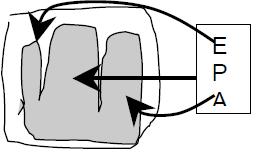
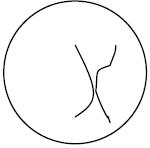
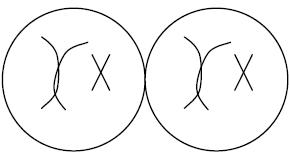
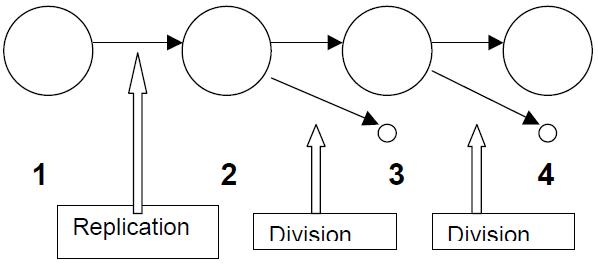
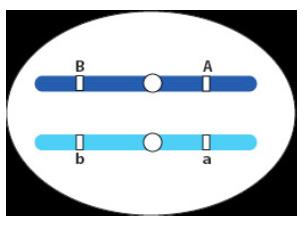
![The following diagram represents an egg following fertilization. Assume 2 pairs of chromosomes in the parent cells. [Disregard the arrowheads.] A true statement about this zygote is that:
The following diagram represents an egg following fertilization. Assume 2 pairs of chromosomes in the parent cells. [Disregard the arrowheads.] A true statement about this zygote is that:
- ProProfs](https://www.proprofs.com/quiz-school/upload/yuiupload/1268087270.jpg)
